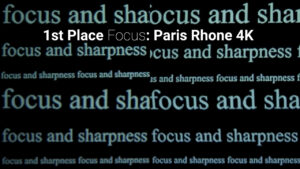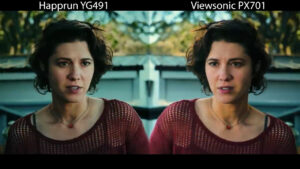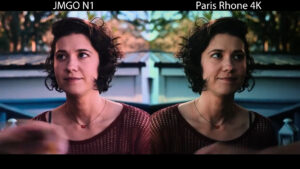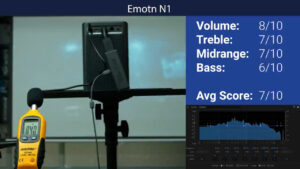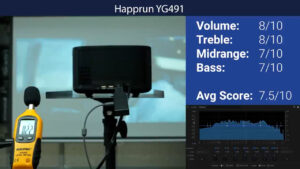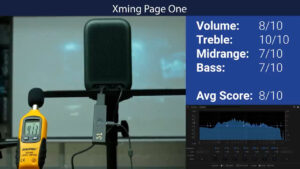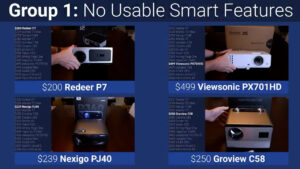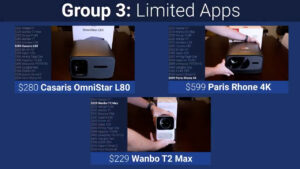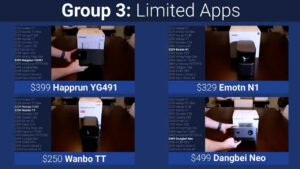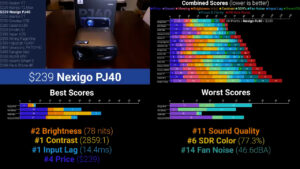15 Budget Home Theater Projectors Tested. Native 4K Under $600!?
February 15, 2024Over the last three years, I’ve reviewed over a hundred projectors from all different price categories, and historically you could get a usable projector around $100 and a very decent projector for $200, but there wasn’t much reason to spend more than that unless you wanted to raise your budget all the way up to about $800. But in this video, I’ve got 15 new projectors priced from $200-$600 to see if doubling or tripling your budget will get you double or triple the performance in 2024.
In the first test we’ll measure their brightness, contrast, color space coverage, and power draw. Then we’ll test ideal placement and off axis focus. We’ll put each projector head-to-head to test viewing experience. After that we’ll test each projector’s fan noise and speaker quality. We’ll look at their Smart OS app compatibility. And finally for gamers we’ll test input lag.
Brightness, Contrast, Color Space Testing
For a price of $200 exactly, the least expensive projector we’ll be testing is the Redeer P7. Like most of the projectors in this price range, the Redeer is a single LCD projector that creates an image by shining a bright white LED light through a 1080p color LCD screen. The P7’s Amazon listing claims to have 1100 ANSI lumens, but in my tests, it only output 601 ANSI lumens while drawing 127 watts of power. Single LCD projectors tend to have higher contrast than DLP projectors and the Redeer was no exception with an impressive 2850:1 contrast ratio and a black floor of 0.024 nits. However, a major downside of single LCD projection is that they tend to have much lower color space coverage, and testing using Calman professional calibrating software and my Portrait C6 Colorimeter the Redeer achieved just 71% coverage of the SDR Rec709 color space, meaning colors will likely look dull compared to a more expensive DLP or triple LCD projector.
After that for $229 is the Wanbo T2 Max 1080p single LCD projector. The T2 Max is significantly smaller and lighter than the Redeer but that comes at the cost of brightness where the T2 Max outputs just 204 ANSI lumens drawing 52 watts instead of the 450 ANSI lumens that Wanbo claims. The black floor of the T2 Max was also slightly higher than the Redeer leading to a much lower contrast ratio of 736:1, and the T2 Max also had lower color space coverage and was only able to display 60.4% of standard dynamic range colors.
Next for $239 is the projector that I’ve been recommending for the last year, the 1080p single LCD Nexigo PJ40 which has received both hardware and software updates since last year’s video, and the version we’ll be looking at today is the PJ40 Gen2. In my testing this version of the PJ40 output 692 ANSI lumens while drawing 140 watts which is 98% of Nexigo’s 700 ANSI lumen claim, and even though the black floor was slightly higher than the Redeer, the additional brightness allowed the PJ40 to narrowly take over first place for contrast at 2859:1. The PJ40 also had significantly better SDR color space coverage at 77.3% putting it in the lead for all 3 categories.
Next for $250 is the 1080p single LCD Wanbo TT which is similar in size and weight to the lower price T2 Max, but unfortunately doesn’t get any closer to Wanbo’s claimed brightness outputting just 253 ANSI lumens, less than 40% of its advertised 650 lumens. The Wanbo TT did have a significantly lower black floor than the T2 Max at 0.019 nits resulting in a respectable contrast ratio of 1632:1, but it unfortunately had the worst color space coverage yet at just 57.8% for standard dynamic range content.
After that, also for $250, is a new projector from Groview, the company that makes the sub $200 projector that I recommend. The Groview C58 is a 1080p single LCD projector that outputs 639 ANSI lumens drawing 120 watts, but has the highest black floor we’ve seen yet at 0.036 nits giving it a contrast ratio of 1817:1, and the C58 had a SDR color space coverage of 70.1% putting it above the Wanbo projectors for both contrast and color space, but well below the Redeer and Nexigo.
Next for $280 is this absolute giant of a projector, the 1080p single LCD Casaris Omnistar L80. Casaris claims that the L80 is the brightest single LCD projector on the market at 1500 ANSI lumens, but in my testing, it achieved slightly less than half of that at 721 ANSI lumens while drawing 171 watts, which is still enough to put it in first place for brightness. The black floor of the Casaris was similar to the Groview at 0.035 nits giving it a middle of the pack contrast ratio of 2062:1. However, the SDR color space coverage was the highest of all the single LCD projectors in this video at 80.8%.
Coming in at $329 is the Emotn N1 1080p single LCD projector. Emotn is a sub brand of Dangbei, who makes excellent laser projectors, but I was disappointed to see that the N1 outputs just 333 ANSI lumens, which is 66% of advertised while still drawing 97.8 watts. And while the N1 had the lowest black floor yet at 0.017 nits for a respectable contrast ratio of 1945:1, it also had very low color space coverage at just 58.9% of standard dynamic range.
Next, for $399, is the Yaber K2S. Yaber is one of the biggest brand names in single LCD projectors and the 1080p K2S is their current flagship. I measured the brightness of the K2S at just 475 ANSI lumens with a power draw of 132 watts, but it had the lowest black floor yet at 0.015 nits giving it the 3rd highest contrast ratio at 2813:1. The Yaber’s color space coverage also finished in the middle of the pack displaying just 65.5% of SDR colors.
Also for $399 is a brand new 1080p single LCD projector from a company called Xming which is a sub brand of the projector giant Formovie. The Xming Page One is very similar in size and performance to the Emotn N1 and claims to have 500 ANSI lumens, but in my testing the Page One was slightly dimmer than the N1 at 319 ANSI lumens, but also had a lower black floor resulting in a very similar contrast ratio of 1864:1. The similarities continued between the Page One and the N1 with color space coverage where the Xming had 58.7% coverage compared to the Emotn’s 58.9%.
$399 was a popular price and the Happrun YG491 1080p single LCD projector was the brightest projector at that price point outputting 492 ANSI lumens while drawing 128 watts. Unfortunately, the Happrun’s black floor was quite a bit higher at 0.031 nits giving it a pretty average contrast ratio of 1770:1 and its color space coverage was also just average, displaying 68.5% of SDR colors.
And that does it for the 1080p single LCD projectors.
Next, for $499 is a completely different projector technology, the ViewSonic PX701HD is a 1080p DLP bulb projector that uses an older technology high intensity discharge bulb combined with a spinning color wheel and digital micromirror display to generate a very bright image with a more economical upfront cost. Some minor downsides of bulb projectors are high heat generation and power use, but the biggest issue is that on normal brightness the bulb will begin to degrade after as little as 500 hours, and will have a significant drop in brightness and color accuracy after around 2000 hours with most people opting to replace the $150 bulb after every 3000 hours of viewing.
In my testing the ViewSonic PX701HD put out 1814 ANSI lumens while drawing 240 watts of power making it two and a half times brighter than the brightest single LCD projector, but only 51% of its advertised 3500 lumens. Unfortunately, with that increased brightness comes a significantly increased black floor of 0.189 nits, which is around ten times higher than most of the LCD projectors, resulting in a less than impressive contrast ratio of 917:1 and a significant amount of light bleed around the screen.
ViewSonic also advertises that you can achieve a similar lifespan to a single LCD projector by using the bulb in SuperEco mode, but in my testing using SuperEco reduced the brightness to 305 ANSI lumens, lowered the contrast ratio to 325:1, and brought the SDR color space coverage down to 69.1% from 85.6% on standard brightness, and even though SuperEco mode is prominently advertised by ViewSonic, I think you’d be crazy to spend $500 on this projector just to use it in SuperEco where it performs worse than projectors that cost a quarter of that price.
After that also for $499 is another different combination of projector technologies. The 1080p Dangbei Neo combines a long lasting LED light source like we see in single LCD projectors with the DLP imager technology from the ViewSonic, which results in lower power consumption and much longer lamp life at the expense of brightness. The Dangbei Neo measured 541 ANSI lumens at just 62 watts, which is exactly as advertised, but unfortunately had a black floor of 0.108 nits, giving it the second worst contrast ratio at 379:1. However, thanks to the LED light source and DLP imager the Neo had by far the best color space coverage yet at 98.9% of SDR and even 90.42% of the HDR DCI-P3 color space.
Next, right at the $600 limit of my price range is another LED and DLP projector, the XGIMI Elfin. In my testing the Elfin put out 574 lumens in bright mode while drawing 53.4 watts and had a black floor of 0.089 nits for a contrast ratio of 535:1, which is higher than the Dangbei Neo, but not nearly as good as any of the single LCD projectors. On the other hand, the XGIMI Elfin had excellent color space coverage displaying 99.7% of the SDR color space and 90.31% of DCI-P3.
Also right at the $600 limit I’ve got the Xiaomi Mi Smart Projector 2, which came in at 354 ANSI lumens drawing 58 watts, which is just 70% of its advertised brightness and that combined with a 0.08 nit black floor gave it an even lower contrast than the Dangbei Neo at 368:1. However, like the Dangbei and XGIMI the Xiaomi had very good color space coverage displaying 94% of SDR colors and 90% of HDR colors.
And last, again at the exact top end of my budget is the $600 Paris Rhone 4K projector, which uses the same single LCD technology as the less expensive projectors in this video but substitutes the single 1080p full color LCD screen for a single 4K full color screen. The Paris Rhone is the exact same size and shape as the Casaris L80 and puts out similar brightness at 684 ANSI lumens which is actually 15% higher than its advertised 600 lumens.
The Paris Rhone also had a very similar black floor to the Casaris at 0.036 nits, which gave it a respectable contrast ratio of 2181:1, but unfortunately, the Paris Rhone’s color space coverage was significantly less than the Casaris displaying just 65.5% of the SDR color space.
Aside from brightness, contrast, and color the next most important things to consider are focus and clarity, and I’ve found that with inexpensive projectors one of the biggest downfalls is poor focus, especially with non-ideal projector placement, so let’s talk about that.
Throw, Offset, and Keystone
The first difference you should know about is that single LCD projectors typically have a vertical offset of around 50%, meaning the projector’s lens will need to be positioned vertically in the middle of your projector screen. 50% offset is convenient for mounting a projector on the wall above a bed or sitting on a bookshelf, but not great for projecting from a coffee table or hanging from a ceiling.
DLP projectors on the other hand tend to have 0 offset, which means the bottom of the screen will line up with the bottom of the lens, which is much better for ceiling mounts and coffee tables.
If your projector doesn’t have the right vertical offset for where you want to put it, you can tilt the projector up or down, but that results in a skewed image that needs to be corrected with vertical keystone.
Similarly, all projectors need to be placed horizontally centered on the screen, and while you can rotate the projector to aim it, that will also cause the image to be skewed which needs to be corrected with horizontal keystone.
All the projectors in this video except the ViewSonic have what I consider to be the most convenient and easy to use form of keystone which is called 4-point, or geometric correction that allows you to pin the four corners of the image directly to your screen using software. Most of the projectors also offer auto keystone using a small sensor on the front of the projector, but in my testing using the manual 4-point keystone was just as fast and gave much better results.
And while the ViewSonic doesn’t have 4-point keystone it does have some other unique options like vertical keystone, vertical lens shift, and optical zoom, but all those have some caveats. First, the vertical lens shift is nice, but no matter where you position the projector there’s always a large area of light bleed around the image and the picture just moves vertically inside of that light bleed area, and second while optical zoom is nice, I found it very strange that the focus on the ViewSonic is not calibrated with the zoom, so at the minimum and maximum zoom ranges there’s no way to adjust the focus knob enough to get even a remotely sharp image. But the ViewSonic is the only projector in this video that can be positioned at different ideal distances, and all the other projectors have a fixed throw ratio.
I recorded the throw distance required for each projector to produce a 100” screen and you can see that the Wanbo T2 Max and Wanbo TT had the shortest throw ratios, and the Redeer and ViewSonic had the longest, and even zoomed all the way out the ViewSonic had the longest throw of 128” and using optical zoom allows placement up to 138” away to produce a 100” well focused screen.
And on the subject of focus, all the projectors in this video except the Nexigo and ViewSonic have motorized focus which I do find very convenient because you can stand right next to the screen when getting it dialed in for perfect clarity.
Focus & Clarity Testing
Which leads me to my next test, which is focus uniformity and clarity. For this test I positioned each projector in an ideal location for a 100” screen with no keystone and projected text of various font sizes onto each corner of the screen. Then I took a close up photo of each corner and then made a composite image to rank each projector for white text on a black background and black text on a white background. In this first test the Paris Rhone 4K projector was a huge standout with extremely clear text, no color fringing, and no focus issues, with the other high performers being the XGIMI Elfin and Xming Page One while some notably poor performers were the Wanbo T2 Max, Casaris Omnistar L80, and Xiaomi Mi Smart Projector 2 which all failed to produce a uniformly focused image even with ideal placement.
In the next test, I offset each projector 20 degrees to the left and used horizontal keystone which generally caused the right side of the screen to be significantly less focused, but the Paris Rhone 4K and XGIMI Elfin still had excellent focus while I thought the ViewSonic PX701HD was the best with the caveat that it didn’t have horizontal keystone so the overall image was still skewed.
Side-by-Side Testing
And now that we’ve measured all the individual aspects of image quality, we should be able to predict which ones will look the best, but in practice things like color accuracy, gamma settings, and on board image processing can make a big difference in viewing experience, so I set up two 100” white screens side by side to evaluate the projectors head to head.
Starting with the projector that is my recommendation under $200, the Groview JQ818C on the left and the least expensive projector in this video the Redeer P7 on the right. In this first round I thought the Groview’s color looked undersaturated and too cool while the Redeer was oversaturated and slightly too warm, but I ultimately went with the Redeer based on higher brightness and noticeably better sharpness, but I did notice that the gamma curve, which is how bright the shadows are compared to the highlights, seemed better on the Groview and was more appropriate for lower brightness projectors like these, allowing more detail in shadowy areas like Henry’s black shirt.
In round 2 the Wanbo T2 Max on the left was up against the Redeer P7 on the right, and the Wanbo was around 30% as bright as the Redeer with less color saturation and less contrast so the Redeer easily won this round.
In round 3 the Nexigo PJ40 was on the left and the Redeer P7 was on the right and seeing them next to each other I could tell that the issue with the Redeer wasn’t that the colors were too warm, but that they were too green and the PJ40’s colors were significantly more accurate and natural.
That made round 4 the Nexigo PJ40 on the left and the Groview C58 on the right, and like the Redeer, the C58 also had heavily green shifted colors and the extra brightness of the Nexigo PJ40 also made the colors pop a bit more without being oversaturated, securing another win for the PJ40.
So round 5 was the Nexigo PJ40 on the left and the Wanbo TT on the right, and again, the biggest issue was that the Wanbo had less than half the brightness of the Nexigo and even in a fully light controlled room 250 ANSI lumens is just not very bright and the PJ40 on the left looked significantly better and easily moved on to round 6 up against the Casaris Omnistar L80 on the right.
And on paper the L80 has higher brightness, and better color space coverage than the PJ40, but that wasn’t what set it apart. Even though the focus on the L80 wasn’t as good, and the contrast looked a little weird to me, the gamma setting on the Casaris made viewing so much better in dark scenes and the amount of additional detail compared to the Nexigo PJ40 was crazy, and I significantly preferred the image from the Casaris.
Round 7 then put the Emotn N1 on the left and the Casaris Omnistar L80 on the right, and this round was absolutely no contest with the N1 significantly lacking in brightness and color space coverage compared to the Omnistar L80.
So round 8 put the Yaber K2S on the left and the Casaris Omnistar L80 on the right and even though there was still something off for me about the color saturation, contrast, and focus of the Casaris, it still looked much better than the Yaber in both light and dark scenes, and again this round was no contest.
The next round put the Xming Page One on the left up against the Casaris Omnistar L80 on the right and it wasn’t even a little bit close, the Casaris having wildly better brightness, contrast, color, and a better gamma curve, outperforming the Xming in every single test scene.
Next in round 9 the Happrun YG491 on the left was up against the Casaris Omnistar L80 on the right, and the Happrun looked fantastic. It had the same great gamma curve as the Casaris without all the weird contrast, focus, and color saturation issues, and despite significantly lower color space coverage I thought the Happrun looked better in every single test scene.
So round 10 was an interesting one, and in all honesty, I expected the ViewSonic PX701HD DLP bulb projector on the right to absolutely embarrass any single LCD projector that I put it against, and in bright scenes it’s hard to argue with three times the brightness paired with much higher color space coverage. However, I thought the Happrun actually held its own in brighter scenes relying on its much higher contrast which is definitely apparent in the texture of Henry’s shirt and the detail in his beard, and in dark scenes the six times higher black floor of the ViewSonic not only looked muddy and gray, but it also made it difficult to see detail and there were quite a few parts where I couldn’t even tell what was happening on the ViewSonic, but the Happrun looked incredible. So, very surprisingly, the Happrun YG491 moved on and the ViewSonic bulb projector was out.
Round 11 then put the single LCD Happrun YG491 on the left and the DLP Dangbei Neo on the right, and in this round I expected the Happrun to absolutely dominate since the Dangbei Neo’s contrast ratio was almost five times lower than the Happrun, and black levels did look a little gray, but the Dangbei looked surprisingly good in both light and dark scenes and I was impressed by both the color and clarity, but the Happrun on the left continued to wow me, easily moving on to round 12 up against the Paris Rhone 4K on the right.
And the Happrun looked as good as ever, with excellent contrast, color accuracy, and that great gamma curve that I’ve mentioned a few times, but seeing the 1080p Happrun next to the 4K Paris Rhone made me think that the Happrun was out of focus, but upon closer inspection it’s just the difference between 1080p and 4K, and the Paris Rhone looked so crisp and clear next to the Happrun. And even though I still preferred the gamma curve on the Happrun, the Paris Rhone did good enough in dark scenes to take the win when considering how excellent the focus and clarity was.
So round 13 put the $600 Paris Rhone on the right up against the also $600 XGIMI Elfin on the left, and despite the XGIMI’s significantly better color space coverage the Paris Rhone looked like it had better color saturation and color accuracy in bright scenes and in dark scenes the superior contrast ratio of the Paris Rhone helped it easily win this round.
And the last projector to go up against the $600 Paris Rhone on the right is the also $600 Xiaomi Mi Smart Projector 2 on the left, and everything about the Xiaomi was terrible. It had terrible focus, terrible gamma settings, terrible contrast, and terrible color accuracy, and while the Paris Rhone was right at the top of the budget category for this video, its performance more or less justifies the price, but I can’t believe I wasted $600 on the Xiaomi which would have probably been outperformed by the $140 Groview JQ818C.
So after that very disappointing final round, I decided to do a bonus round for anyone considering stretching their budget a little further, with the $600 Paris Rhone on the right and the $800 JMGO N1 on the left, which was one of my favorite projectors from my portable projector video. As we’ve covered the Paris Rhone is a 4K single LCD projector with an LED light source while the JMGO N1 is a 1080p DLP projector with a triple laser light source, and I know it’s $200 more, but I was just as impressed with the JMGO N1 during this test as I was the last time I tested it.
Not only is the color space coverage excellent, but the gamma is also super dialed in revealing tons of extra detail in dark scenes, and while the resolution of the Paris Rhone was obviously higher the JMGO N1 still looked crisp and focused due to its laser light source. The Paris Rhone did have higher contrast and a lower black floor, but it’s hard to argue with the picture quality of the JMGO N1.
Still, staying in the $200-600 budget range, I did some additional side by side testing and this was my final ranking for picture quality and overall viewing experience with the 4K Paris Rhone on top, followed by the Happrun YG491 the Casaris L80 in 3rd, and the ViewSonic PX701 in 4th.
Speaker Quality
At this price point I think it’s also reasonable for people to want to use the built-in speakers with these projectors, so I played the same clip from Star Wars Episode 9 and ranked each projector based on overall volume, bass, midrange, and treble performance, and here they are from worst to best, separated into 3 categories, first are the internal speakers I would never consider using.
The second category are the speakers that would work in a pinch but are not a permanent solution.
And third are the speakers that I would have no issue watching an entire movie with.
Fan Noise
Also, on the subject of sound, the fan noise of these projectors varied significantly and here they are from quietest to loudest. (see YouTube video)
Smart OS Testing
Another feature that seems to be heavily emphasized in this budget range is the inclusion of a smart operating system and built in apps, and in general I would always recommend using an external streaming stick like a FireTV, but I did evaluate the quality and compatibility of the built in operating systems and apps and divided them into four groups.
First are the projectors I would consider having no usable smart features like the Groview JQ818C, Redeer P7, Nexigo PJ40, Groview C58, and ViewSonic PX701HD, and with these projectors you’ll definitely need to buy a streaming stick or have some other external source.
Second are the projectors that advertise a SmartOS, but have pretty poor app compatibility and performance and you’re likely to still want a streaming stick, and those are the Wanbo T2 Max, Paris Rhone 4K, and Casaris L80 which use an Android 9 operating system with mouse mode to operate apps like Netflix and Amazon Prime Video, and while they technically work they are wildly inconvenient and don’t support full resolution video playback.
Third are projectors that use the NetRange app store which includes the Wanbo TT, Emotn N1, Dangbei Neo and Happrun YG491. Unlike the second group of projectors that repurpose apps meant for cell phones, NetRange offers full compatibility and licensing for Netflix and Amazon Prime, but other app availability is sparse and there’s no YouTubeTV, Disney+, AppleTV, or HBO Max, so you’ll need a streaming stick if you want to use those apps. This group also has the XGIMI Elfin which has AndroidTV 10 and generally has very good app compatibility, but isn’t Netflix certified, so you’ll need to use the workaround version built for mobile devices.
And the fourth group are the projectors with fully functional built in smart operating systems that you could use without a streaming stick which are the Yaber K2S which comes with a Netflix certified AndroidTV 12 dongle, the Xiaomi Mi Smart Projector 2 which uses AndroidTV 9 but still somehow manages full app compatibility, and the Xming Page One which uses the most recent version of GoogleTV giving it the best app compatibility of all the projectors in this video.
Gaming Input Lag Testing
And specifically for gamers the last thing to talk about is input lag, which is the delay between when a signal is sent to the projector and when it is displayed on the screen. Things like digital keystone and advanced image processing tend to increase input lag, which can cause a serious problem for fast paced video games. To test their best possible performance, I set up each projector with no keystone and put them into their specific game modes where available. I then tested their input lag using the Leo Bodnar lag meter set to 1080p60hz and used that information to divide the projectors up into four groups.
The first group are the projectors with over 100ms of lag which you basically can’t use for playing video games, and that includes the Casaris L80 and Wanbo T2 Max.
The second group have input lags between 60 and 100ms which may work for casual games and racing games but won’t work well for first person shooters or platformers, and that group has the Yaber K2S, Dangbei Neo, Xiaomi Mi Smart Projector 2, Happrun YG491, Emotn N1, and Paris Rhone 4K.
The third group is between 20-60ms which is more than fine for most non-competitive gamers and that group has the Redeer P7, Wanbo TT, Groview C58 and Groview JQ818C.
And the fourth group are the sub 20ms projectors that should satisfy even the most competitive gamers, which are the ViewSonic PX701HD in 3x fast input mode, the Xming Page One in game mode, and the Nexigo PJ40 in game mode.
Conclusions
So, it’s conclusion time, and after all this testing I gave each projector an individual ranking for each category and tallied up the scores, where lower scores are better.
Coming out on top is the Nexigo PJ40 with a total of 60 points, scoring particularly well in the brightness, contrast, input lag, and price categories, but performing poorly when it came to sound quality and color space coverage. The fan noise was a little loud at max brightness, but the PJ40 does have a variable speed fan, so you can set it to whatever you find acceptable, and it will adjust the brightness of the LED light source accordingly.
My biggest disappointment with the PJ40 was the relatively low performance in the side-by-side testing when it came to low light scenes due to a higher gamma setting than I would prefer, and it seems like that may have been a common issue.
The PJ40 that I used in this video was purchased from Amazon and is what they call “Gen2”, but I also have a “Gen3” unit where they have enabled the full custom picture settings menu from Android which gives access to custom gamma settings and 11 point white balance and adjusting those to a gamma of 1.8 significantly increases the performance of the PJ40. Here’s a side by side of the PJ40 Gen2 on the left and the Gen3 on the right and you can see how much the custom gamma settings increase performance in dark scenes, and here’s how it looks next to the Paris Rhone in those same scenes.
I spoke with Nexigo and they said that they still have stock of the Gen2 PJ40, so if someone were to click on their main listing they will receive the older Gen2, but they also set up a separate listing for the Gen3 which I’ve got linked below so you can get it now.
Stepping up quite a bit in price, the Paris Rhone also performed very well with a total score of 63 with high scores in picture quality, focus, brightness and sound but poor rankings in color, input lag, and of course price, but if you’re not a gamer and you’re just looking for a crisp clear image in a light controlled home theater I think the Paris Rhone is a pretty good option at $599, but would be a really excellent value if it were priced between $450 and $500.
Also, at the top of the price range the XGIMI Elfin tied for 2nd with 63 points total with high scores in color, fan noise, and off center focus, but had middle of the road brightness and viewing experience scores mostly due to its relatively poor contrast.
Between the two at that highest price point I think the Paris Rhone does give a significantly better viewing experience than the XGIMI Elfin as long as the overall size, fan noise, and increased input lag aren’t deal breakers for your setup, especially since DLP technology can also introduce the rainbow effect for some people but will never be an issue with a single LCD projector.
As a reminder there are no sponsored reviews on this channel, but I do have below for all the projectors in this video and as always, I appreciate when you use those links since as an Amazon affiliate I do earn a small commission on the sale at no cost to you.
I’d also like to thank all of my awesome patrons over at Patreon for their continued support of my channel, and if you’re interested in supporting my channel and getting in on my monthly giveaways, including a projector from this video, make sure you check out the link below. If you enjoyed this video don’t forget to hit that thumbs up button and consider subscribing to my YouTube channel and as always, thanks for watching The Hook Up.
Best Score Overall: Nexigo PJ40 (Gen3)
- AmazonUS (Gen3): https://amzn.to/3OKpgK2
- AmazonCA (Gen 3): https://amzn.to/3UQ4hcu
- AmazonUS (Gen2): https://amzn.to/3HYXF3V
- AmazonCA (Gen 2): https://amzn.to/42UFGVQ
Best Viewing Experience: Paris Rhone 4K
- AmazonUS: https://amzn.to/3UBXDXb
- AmazonCA: https://amzn.to/3UTDmwp
Budget Stretcher ($799): JMGO N1 TriLaser DLP
- AmazonUS: https://amzn.to/3HYru4u
Other Projectors Tested (ordered by viewing experience score)
- Happrun YG491: https://amzn.to/49gFCC2
- Casaris OmniStar L80: https://amzn.to/3us8BE6
- Viewsonic PX701HD: https://amzn.to/3UCy34n
- XGIMI Elfin: https://amzn.to/3uFqG1q
- Groview C58: https://amzn.to/3OHURvy
- Redeer P7: https://amzn.to/49AQ86X
- Dangbei Neo: https://amzn.to/3I3Wv7f
- Wanbo TT: https://amzn.to/3OJHdIl
- Xming Page One: https://amzn.to/3P7U6fR
- Emotn N1: https://amzn.to/48lBkYZ
- Yaber K2S: https://amzn.to/4bwhj4G
- Groview JQ818C: https://amzn.to/48fQ0c1
- Wanbo T2 Max: https://amzn.to/3wh0WsP
- Xiaomi Mi Smart Projector 2: https://amzn.to/49gFO4e
**As an Amazon Affiliate I earn a commission on qualifying purchases at no cost to you**























